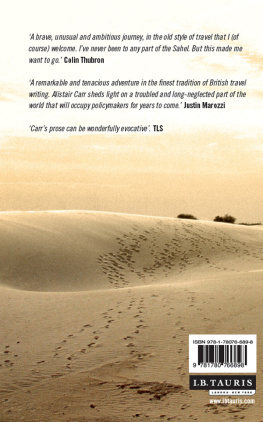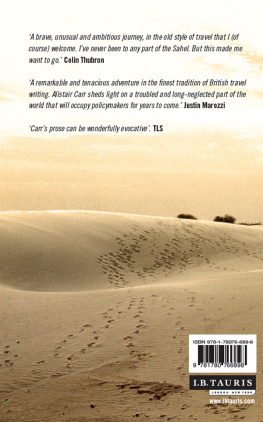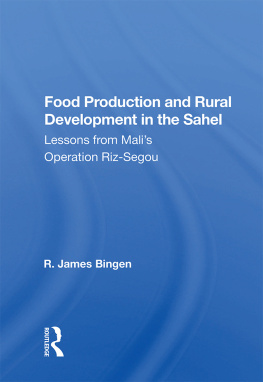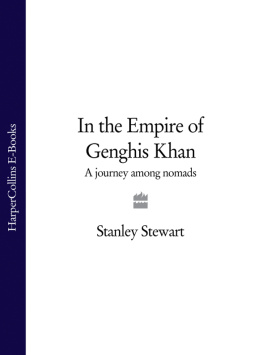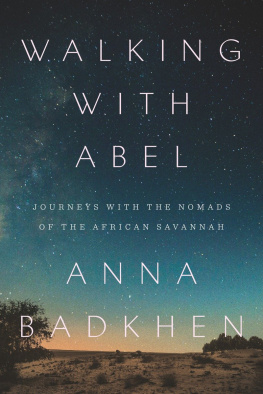Alistair Carr is a Fellow of the Royal Geographical Society, and is author of The Singing Bowl Journeys through Inner Asia. He lives in Suffolk with his wife.
A brave, unusual and ambitious journey, in the old style of travel that I (of course) welcome. Ive never been to any part of the Sahel. But this made me want to go. Colin Thubron
A remarkable and tenacious adventure in the finest tradition of British travel writing. Alistair Carr sheds light on a troubled and long-neglected part of the world that will occupy policymakers for years to come. Justin Marozzi
Carrs prose can be wonderfully evocative. TLS

Published in 2014 by I.B.Tauris & Co Ltd
6 Salem Road, London W2 4BU
175 Fifth Avenue, New York NY 10010
www.ibtauris.com
Distributed in the United States and Canada Exclusively by Palgrave Macmillan 175 Fifth Avenue, New York NY 10010
Copyright 2014 Alistair Carr
The right of Alistair Carr to be identified as the author of this work has been asserted by him in accordance with the Copyright, Designs and Patents Act 1988.
All rights reserved. Except for brief quotations in a review, this book, or any part thereof, may not be reproduced, stored in or introduced into a retrieval system, or transmitted, in any form or by any means, electronic, mechanical, photocopying, recording or otherwise, without the prior written permission of the publisher.
ISBN: 978 1 78076 689 8
eISBN:978 0 85773 454 9
A full CIP record for this book is available from the British Library
A full CIP record is available from the Library of Congress
Library of Congress Catalog Card Number: available
Typeset by 4word Ltd, Bristol
CONTENTS
ILLUSTRATIONS
Figure
Fardes letter of 15 April 1690 from the corsair port of Sale |
Plates
The Wodaabe |
Wodaabe clothing |
Zebu |
Tuareg culture |
Zinder palace guard |
Camel market |
Ahmet and Omar |
Our travelling companions |
Tubu weapons |
Saddling up |
A Manga well |
Sassai school |
Binti |
Sassai elder |
Inside a Tubu winter tent |
Tubu belongings |
A Tubu summer hut |
View from a Tubu hut |
Rock art |
A view from the air across the Tnr desert |
Tubu women |
A Fulani home |
The Fulani |
Tending to the goats |
Elhadji Sali |
As Ahmet saw me |
Laraba |
Larabian children |
Maps
The Principal Caravan Routes of the Nineteenth Century |
Sahara and Northwest Africa showing Agades from Joan Blaeus 1665 Atlas Maior: Africae Nova Descriptio |
Traditional Tuareg and Tubu regions |
ACKNOWLEDGEMENTS
F irst and foremost, I would like to thank my guides: Omar and Ahmet. My life was in their hands for the duration of our journey across the Manga. I am also immensely grateful for the hospitality given to us by all the Tubu we stayed with along the way. Thank you to Leslie Clark, Charlene Pidgeon and Peroji for the travels with the Wodaaabe, and to Richard Grail for letting me stay in his Agades home. Thanks also to Carol Beckwith, Professor Jeremy Keenan, Professor Harry Norris and Dr Amira Bennison; to the late Paul Marsh, my agent, for being so supportive of this project and to Geraldine Cooke, Stephen Davies and Janice Brent. Thank you, also, to Colin Thubron for helpful manuscript observations.
And, of course, thanks to Sarah for being so wonderfully loving, patient and understanding.
For Sarah
In memory of Ray, Mark and Ross Hanna
INTRODUCTION
A lmost three years had passed since I last heard the tones of a camel growl, when I sat under a leafy trellis in Agades sipping a refrigerated drink of ginger, spices and lemon juice. The muezzins chant glided across the Saharan town and I listened with contained excitement as Eva Macher, an Austrian in her early fifties, described how there was a vast region to the north-east of Zinder that was untouched by the modern world: few, if any Caucasians, had ever penetrated the place.
Where youll be going, and living with the nomads who are there theyre true nomads, Eva ruminated, as a breeze ruffled the overhead canopy. No outside contact at all youll never get ill with them.
Like the Aborigines, I replied.
Exactly, she remarked, as sunlight splintered into a fistful of diamonds around us. But, she continued, I think in three years, even there, that way of life would have disappeared.
I had not forgotten Niger or its nomads, but this conversation, recorded in my journal during the trips closing week, had been mislaid among the pages of lifes intervening chapters. I had travelled there for the Ars rock art. Scientists make copies of petroglyphs in the manner of a brass rubbing, but they mostly use charcoal; I planned to work with colour oil and soft pastels with a view to then selling the prehistoric images at a London gallery. The two months I spent in Agades, the Tnr desert and the Ar Mountains, with its memories of half-mile-high dust devils, xanthic shades, robed Tuaregs and prickling heat, all seemed a long time ago but I sensed that I would have to return, because there was a feeling of an incomplete journey.
In my subsequent enquiries into the history of Agades and the role it played in the Old Salt Road, I forgot my own journey and became more interested in those that others had undertaken over the centuries either by choice or unhappy fate. By the time I decided to return to Niger, I had lost sight of north-east Zinder entirely and, instead, hoped to accompany one of the Tuareg salt caravans on the final annual leg of their return journey south from Agades to Katsina an ancient salt road entrepot in northern Nigeria.
Then I read, with mounting frustration, of the burgeoning Tuareg rebellion that flared up in the Ar Mountains during February 2007 and, over the next few months, from the safe confines of my Suffolk home, I followed the rebels progress with a muted sense of dismay. With each new attack as in June, when the Tuaregs shot up Agades airport, then defeated two columns of government troops in the desert the likelihood of my return to Niger diminished. Aghaly ag Alambo led the rebels, who called themselves the Mouvement des Nigriens pour la Justice (Niger Movement for Justice), or MNJ, and they claimed the government had failed to honour the 1995 peace agreement that ended the first Tuareg rebellion (19905). The new rebellion had started, as one source put it, because of the culmination of widespread disaffection amongst Tuareg ex-combatants with the slow progress of promised benefits, lack of functioning democratic institutions, and a perceived special status given to foreign mining interests and political leaders.
The MNJ attacks were making an impact but, for Agades, it was bad news, as the already fickle tourist trade would disappear entirely until the conflict was resolved. Agades, as I remembered with its lively collage of desert peoples attired in robes, turbans and swords smelt of baked dust and its back streets had all the disorientating traits of the desert; the narrow alleys, medieval in character, twisted and meandered like a trickle of water pushing its way through a carpet of dust: one alley filtered into another, a left turn, then a right and it all looked the same. There were few trees and little shade in the town, and the September heat sucked the moisture from both the animate and the inanimate; baguettes baked at 6 oclock in the morning became crusty and brittle by midday and, if squeezed in the hand, would disintegrate into crumbs as temperatures rose to over 100F in the shade.
Next page
